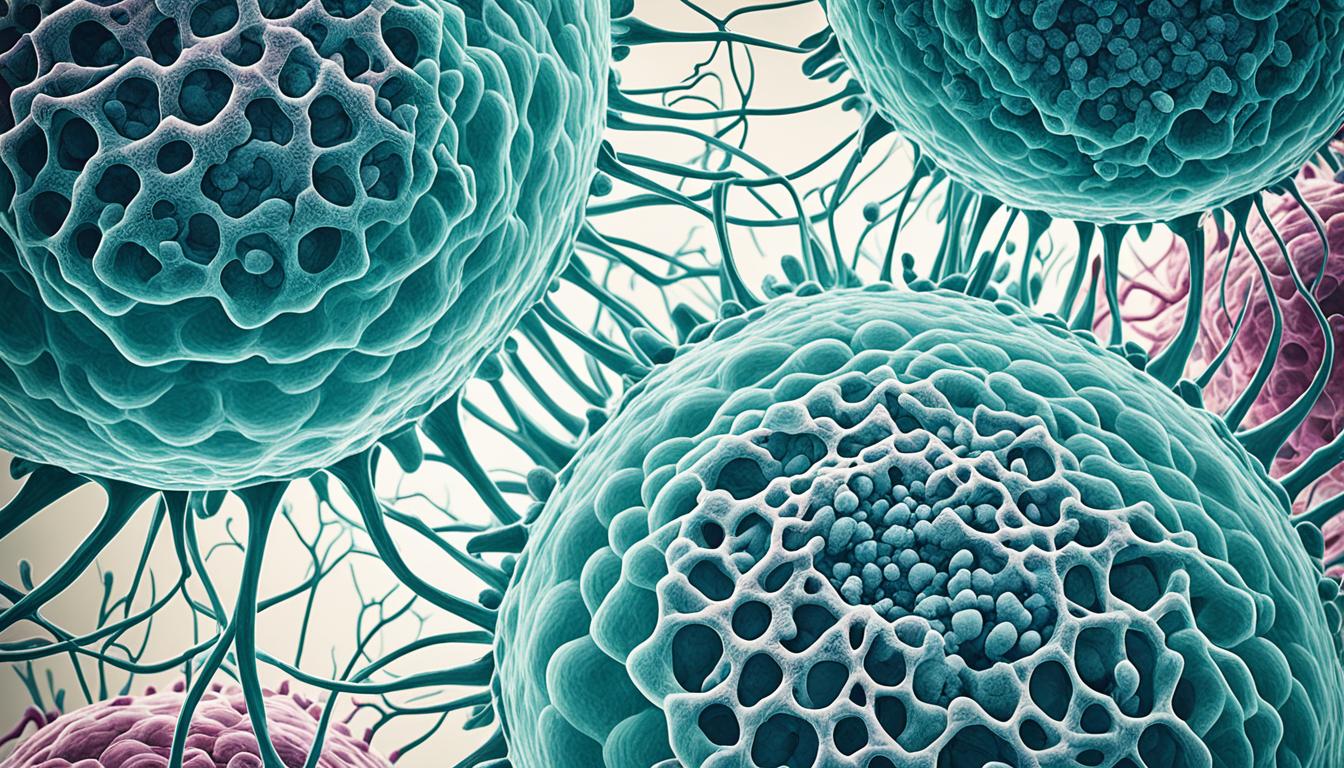Carcinoma of unknown primary (CUP) means doctors can’t find where the cancer started. It quickly spreads to other parts and doesn’t respond well to usual treatments. People with CUP might lose weight without trying, feel very tired, have pain, and find that their lymph nodes are bigger. The cause is a mystery, and it’s not common.
Finding out if someone has CUP can be hard. Doctors use many tests, including medical history, physical checks, blood work, and pictures of the body. The aim is to spot a main tumor and figure out the cancer type.
Recently, scientists have been looking into using stem cells to treat CUP. Studies have shown good signs. This brings new chances for those fighting this difficult illness.
Key Takeaways:
- CUP is a type of cancer where the primary tumor cannot be identified at diagnosis.
- Patients with CUP may experience symptoms such as weight loss, fatigue, pain, and enlarged lymph nodes.
- Diagnosis of CUP involves thorough medical history, physical examination, blood tests, imaging studies, and pathology evaluation.
- Stem cell therapy has emerged as a potential treatment option for CUP, with promising results in clinical trials.
- Further research is needed to improve diagnostic and treatment strategies for CUP.
Understanding the Biology of Carcinoma of Unknown Primary
Carcinoma of unknown primary (CUP) is not easy to fully grasp. It’s thought to start when cells multiply without control. These cells can travel to other places in the body before a main cancer tumor is found. They can do this by changing in a way that lets them move through the body’s tissues more easily.
Doctors use tests that look at the genetic and molecular makeup of cells to figure out where CUP comes from. But, pinpointing the primary site has proven difficult. CUP tumors show surprisingly different features and can change independently from any primary tumor.
Role of the Tumor Microenvironment
Within CUP, the environment around the tumor is crucial. It includes normal cells, blood vessels, and what’s between cells, called the matrix. These support the way cancer cells change and move through the body.
Research shows that immune cells, fibroblasts, and cells that line blood vessels play key roles in this environment. They make and release molecules that help tumor cells survive, move, and settle in other places. Learning how all these parts work together is important for treating CUP effectively.
| Key Factors in the Biology of CUP | Descriptions |
|---|---|
| Clonal proliferation | Rapid and uncontrolled growth of cancer cells. |
| Metastasis | The spread of cancer cells to distant sites in the body. |
| Epithelial-to-mesenchymal transition (EMT) | The process by which tumor cells acquire the ability to invade and metastasize. |
| Genetic abnormalities | Alterations in the DNA of cancer cells that drive tumor progression. |
| MicroRNA | Small RNA molecules that regulate gene expression and can be used for tissue classification in CUP. |
| Gene expression profiling | Analyzing the activity levels of genes in cancer cells to infer the tissue of origin. |
| Parallel progression model | The concept that CUP and the primary tumor may have independent genetic alterations. |
| Tumor microenvironment | The surrounding non-cancerous cells, blood vessels, and extracellular matrix components that influence tumor growth and progression. |
We are working to understand CUP’s genetic and molecular problems better. This will help improve how we diagnose and treat it. With deeper knowledge, we aim to find treatments that suit the unique nature of this disease and better help patients.
Potential Advances in Diagnosis and Treatment of Carcinoma of Unknown Primary
New methods are making it easier to spot the main cancer site in carcinoma of unknown primary (CUP) patients. PET/CT scans are at the forefront using a special type of dye, called fluorodeoxyglucose. These scans are amazing at finding cancer that has spread, which helps doctors plan the next steps well. They boost the accuracy of finding the cancer and help decide on the best treatment options.
Doctors are also taking a closer look at genes and molecules to pinpoint where the cancer started in CUP. Even though we’re still learning about how accurate and useful these tests are, they could open the door to treatments that target the tumor’s specific traits. This focus on the cancer’s biological details might lead to custom treatment plans, giving each patient the therapy that fits them best.
Stem cell therapy is showing promise as well. Studies point to its benefits, like keeping the disease under control and improving how long patients live. For those with CUP, this therapy is a bright new path to explore for better care.
Yet, living with CUP is tough, and the future can look dim. More work is needed to make detecting and treating CUP more effective. And this work calls for constant teamwork and commitment from the oncology experts. These efforts aim to find new solutions and bring hope to those fighting carcinoma of unknown primary.
Conclusion
Carcinoma of unknown primary (CUP) is a hard to catch disease. It’s tough to diagnose and treat. New technology like PET/CT scans and genetic testing are changing things. They help find where the cancer started. Knowing this can lead to better treatments for patients.
Stem cell therapy is also giving hope for CUP. It’s a new approach that’s still being studied. This research could help find better ways to treat CUP.
Even with these new steps, the outlook for CUP patients isn’t good. More work and sharing between doctors and researchers are needed. They’re trying to learn more about CUP. By combining new tests, targeted drugs, and stem cells, things could get better for CUP patients.

